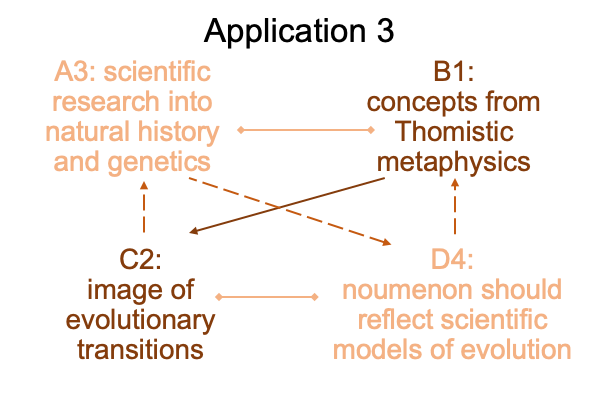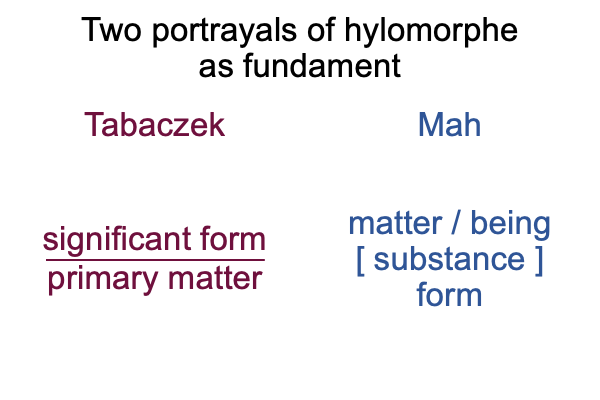0670 Here comes application three.
In chapter one, just as science (A) projects its own image onto the mirror of theology (D), Tabaczek (B) casts the image of Thomistic metaphysics into the sciencemirror of evolutionary transitions (C).
I wonder, “What will come of that?”

0671 According to Aristotle, things have hylomorphic structure.
To me, Aristotle’s hylomorphe is an exemplar for Peirce’s category of secondness (points 0611 to 0640).
This leads to a problem with nomenclature. My portrayal of the hylomorphe is precisely the opposite of Tabaczek’s portrayal.
Not “opposite”. Rather “upside-down”.
Here is a picture.

0672 Am I playing a word game?
What is the difference between a thing as itself and a hylomorphe?
A thing itself is mind-independent.
A thing as hylomorphe is mind-dependent. When a human encounters a thing, the thing has two contiguous real elements, roughly corresponding to presence and shape. This precisely corresponds to Peirce’s definition of the category of secondness, the realm of actuality.
0673 As long as humans use spoken words as labels, we can draw a distinction between these two facets of a single thing.
But, for the longest time, our hominin ancestors practice hand- and hand-speech talk, which is unable to explicitly abstract these two real elements from the thing itself. One can pantomime and point to the thing itself (or one of its features). But, one cannot image or indicate its matter or its form separately. Nevertheless, one can be aware that the thing itself has presence and has shape. So, it may be weird to say this, but the difference between matter and form is built into our bodies and our souls as an implicit abstraction, rather than as an explicit abstraction.
Yes, the implicit abstraction of matter and form is a feature of our phenotype. It is an adaptation.
0674 Because humans intuitively respond to things as matter and form, roughly presence and shape, then Tabaczek (B1) may reasonably expect that the evolution of creatures, as the evolution of {matter and form}, might offer an acceptable image of evolutionary transitions (C2).
0675 Well, forget that!
Where do hylomorphes fit into the disciplinary languages of either natural history or genetics?
Is matter an actuality independent of the adaptive species (AIAS), such as the environment of evolutionary adaptation(EEA)? Is form an adaptation?
Is matter DNA? Is form the phenotype?
“Well, yes,” I say, “to all these questions, and I also may add that hylomorphes, such as matter [contiguity] form, also associate to observations of phenomena, where the observation intuitively produces a hylomorphe.”
The scienceagent (A3) replies, “I sure wish the positivist intellect was still alive. This metaphysics business is not for me.”
